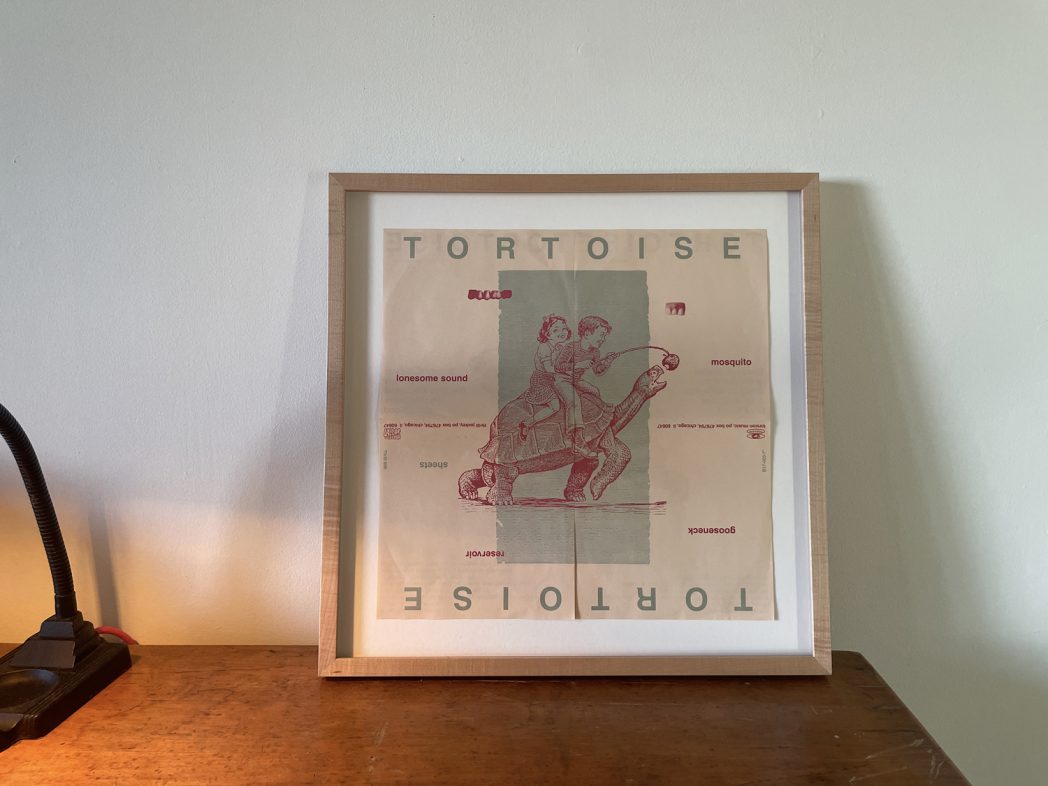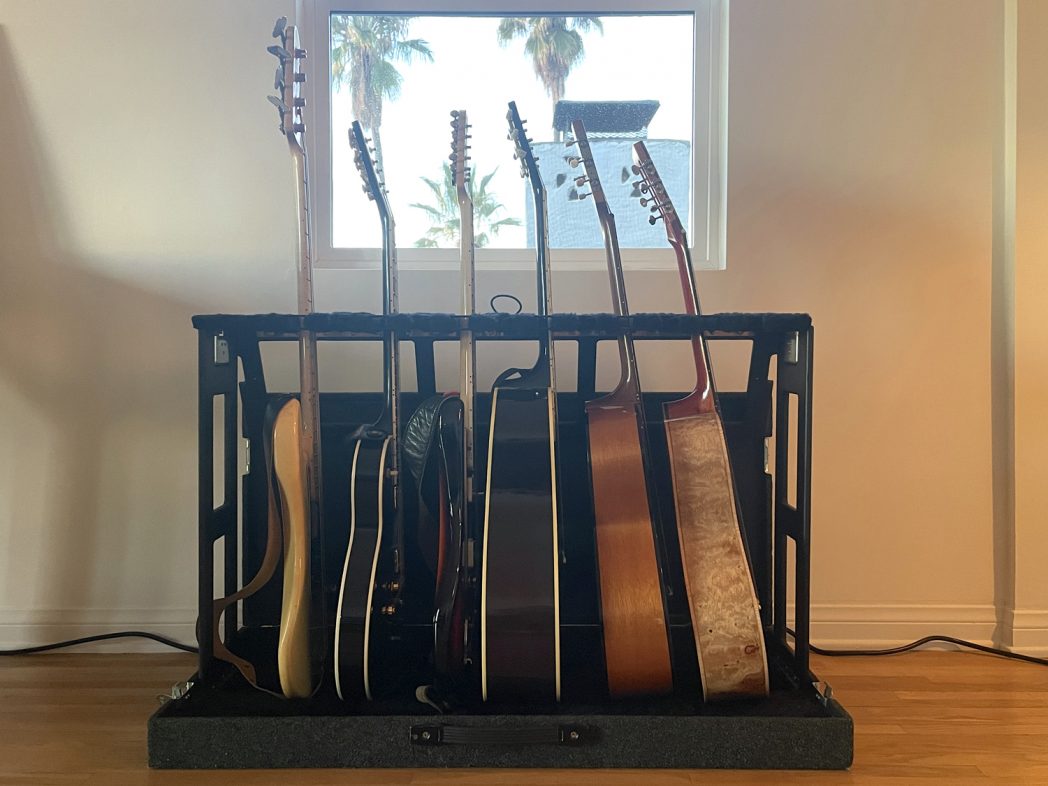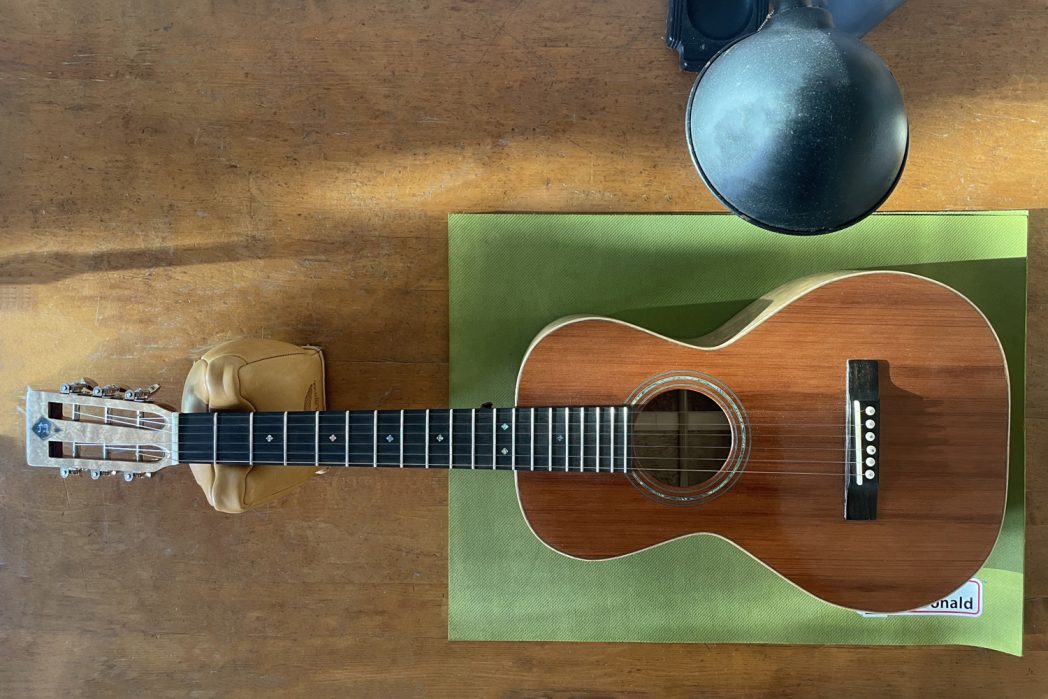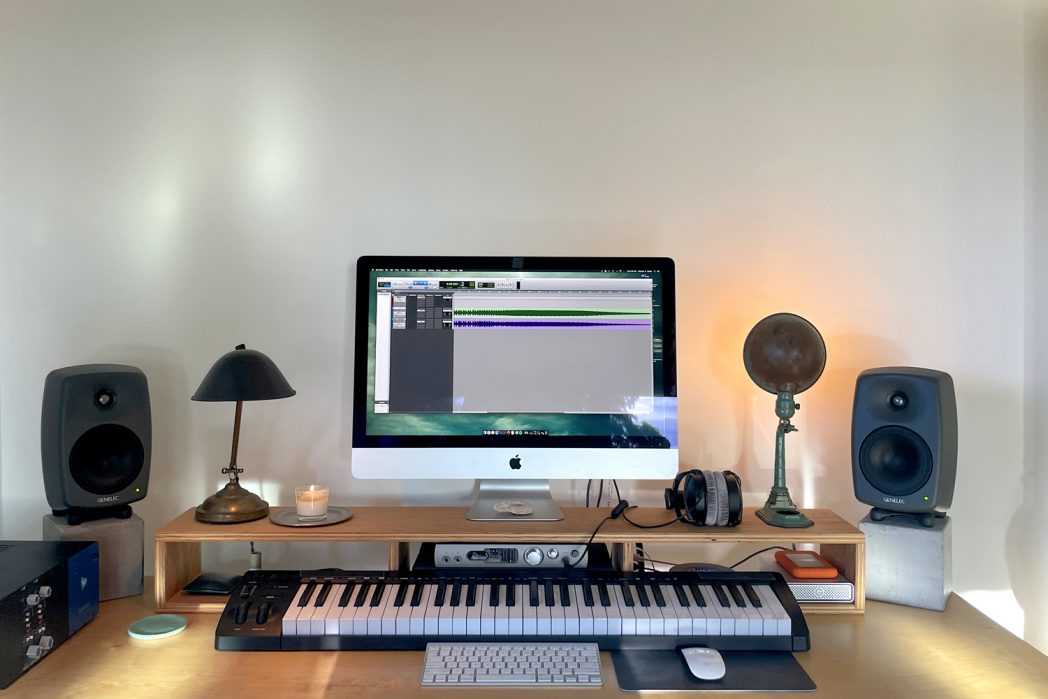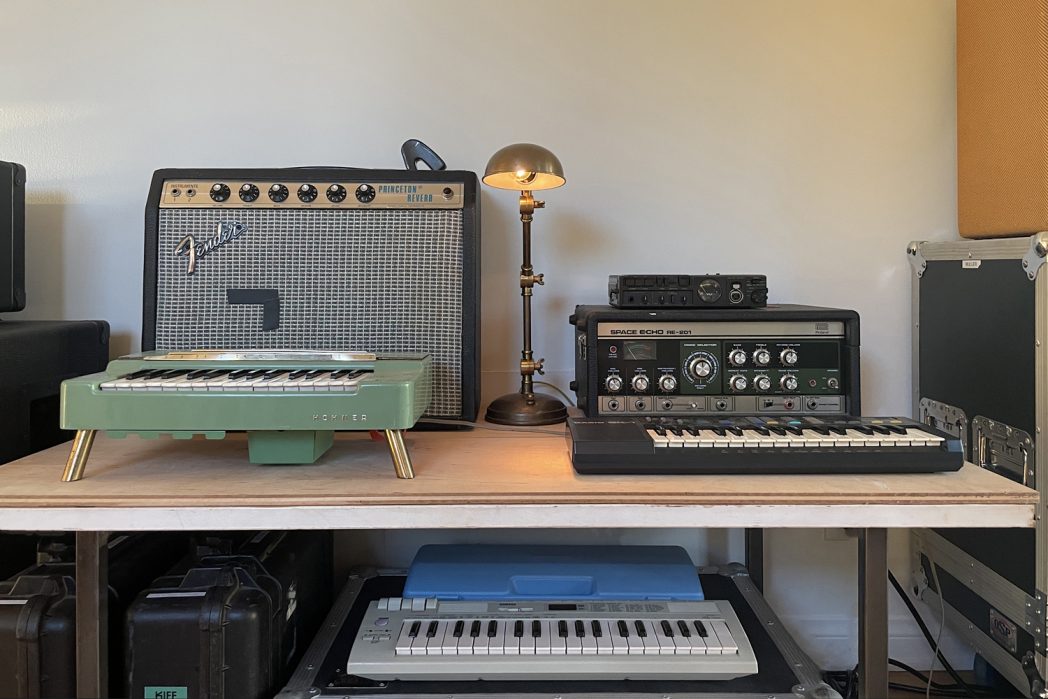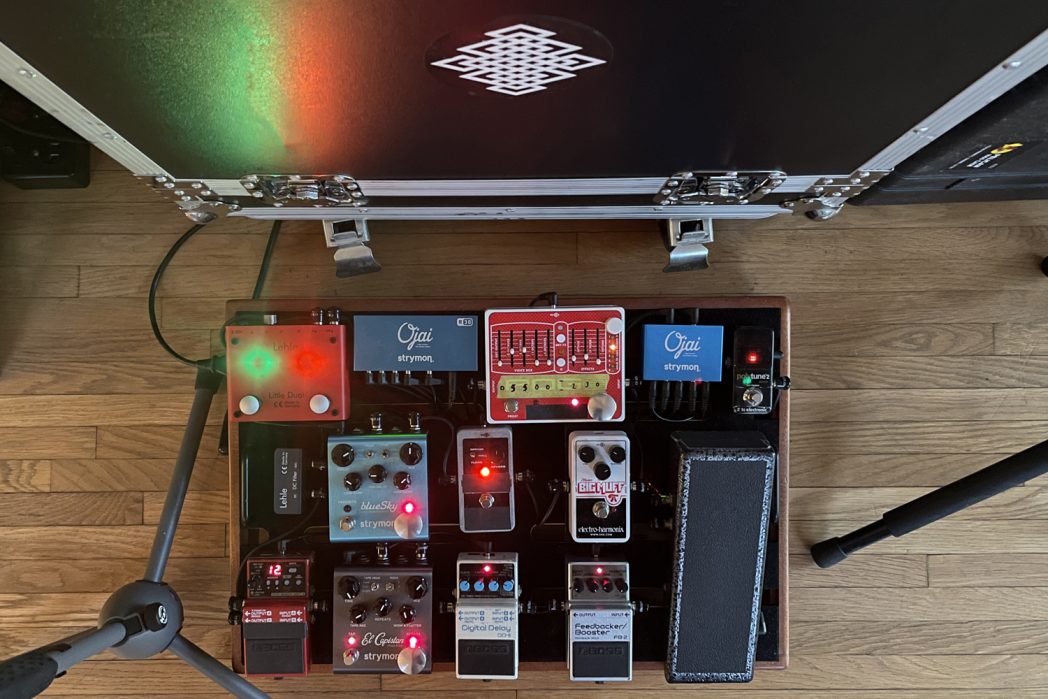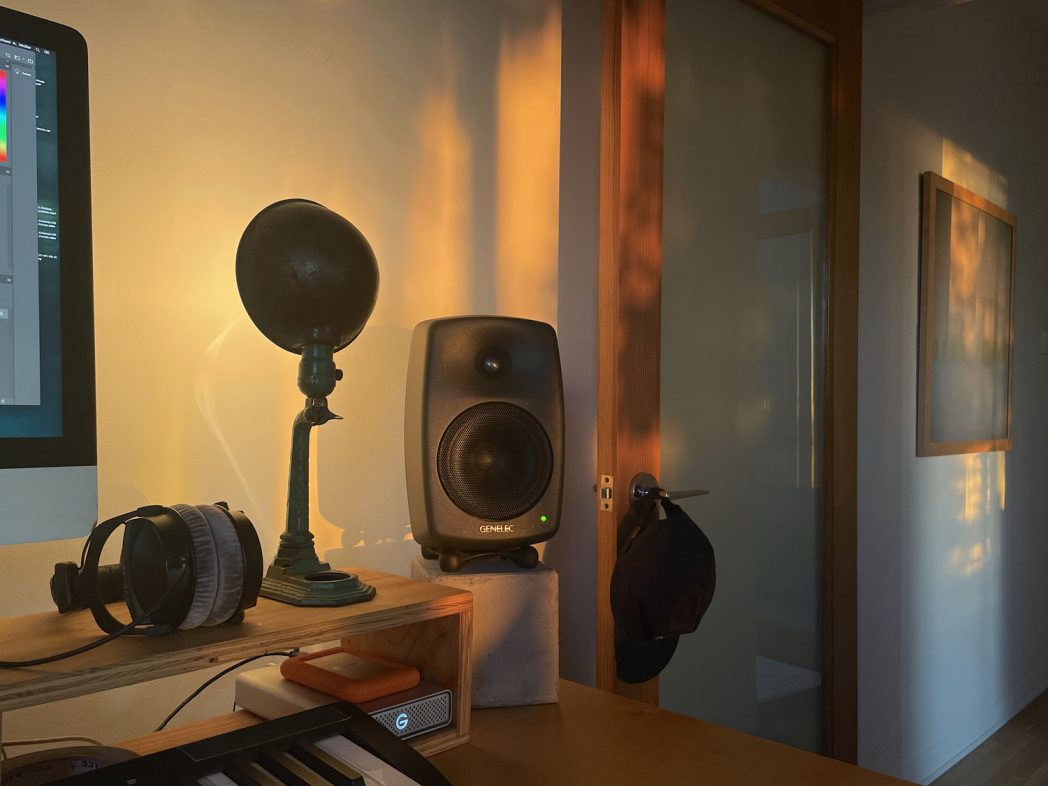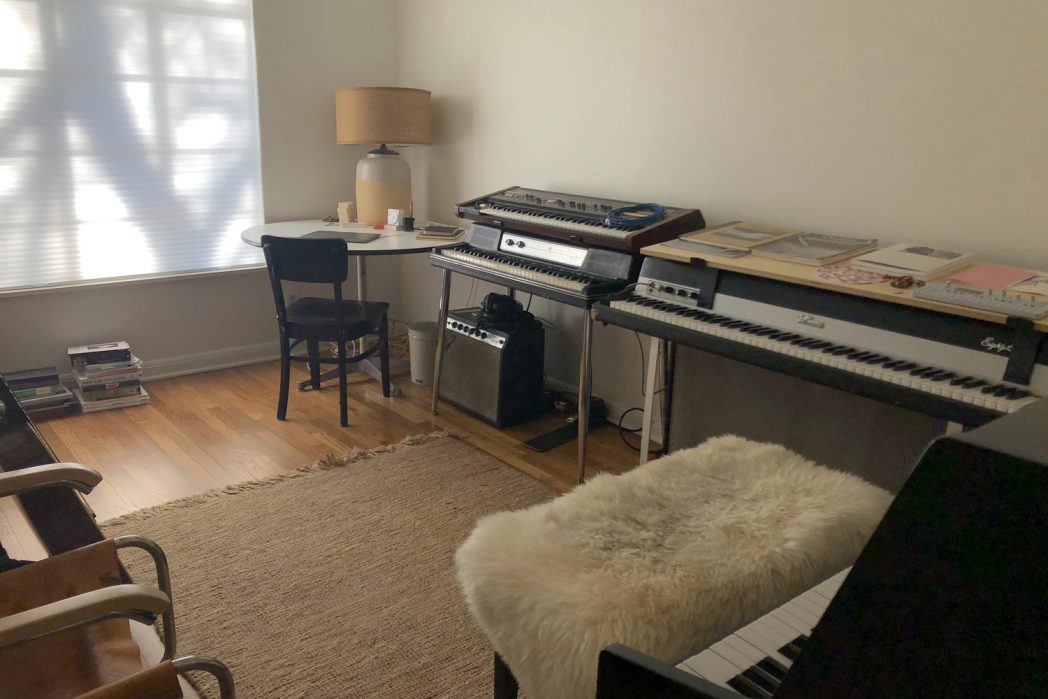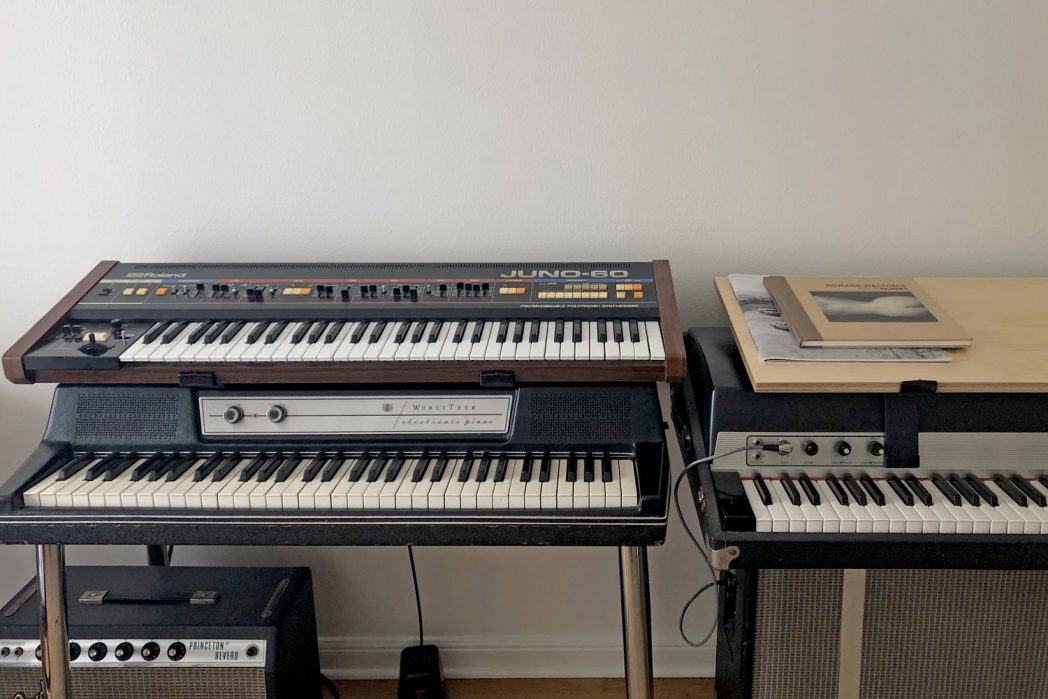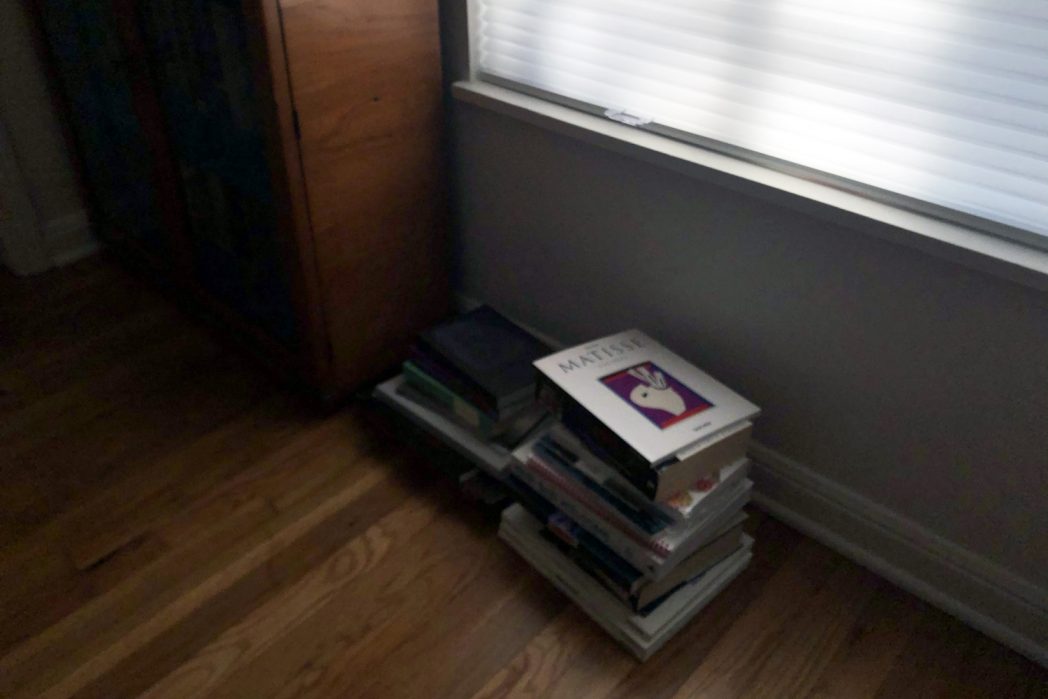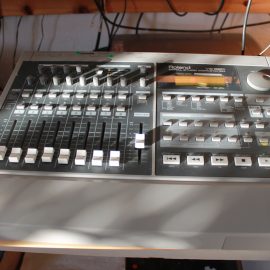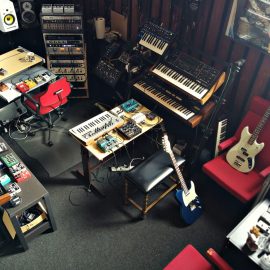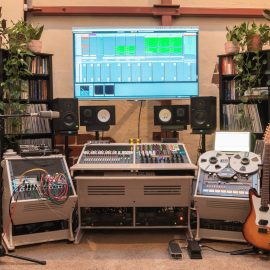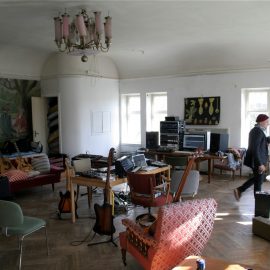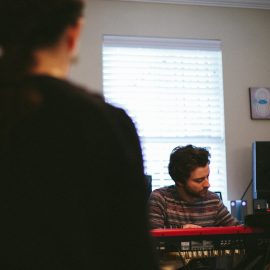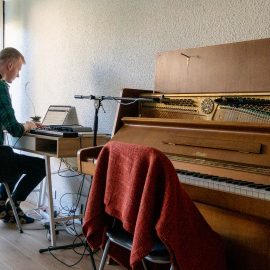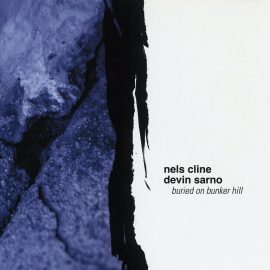[Editor’s Note: the duo’s answers are furnished by Michael A. Muller (MM) and Rob Lowe (RL). The first half of photos are from Muller’s studio and the second from Lowe’s. There will be a note in the text indicating the transition.]
Let’s start at the very beginning. Can you tell us how you got involved in composing, and what was your very first piece of gear?
MM: My father bought me a 3/4-size classical concert guitar when I was 5 years of age due to my apparent keen interest in listening to music, dancing and emulating live performance. Just before I got my first guitar, I remember tying a shoestring to both ends of a broom handle and pretending to play “guitar” along with music in the house. My parents mostly listened to American and British rock-n-roll, with an occasional tinge of new age, reggae and doo-wop. My father played folk guitar and would sing my brother and me songs each night before bed. Usually some rendition of Bob Dylan, The Clancy Brothers or the Kingston Trio. I took some guitar lessons back then, but my attention span wasn’t quite ready. I also took a year of beginner piano but never fully invested my time and energy toward music until I was 12 years old and I got my first electric guitar (Fender Stratocaster) and started taking more serious lessons on basic guitar theory on a weekly basis. At that time, I was mainly interested in learning Metallica and Iron Maiden songs. Later in high school, after the grunge scene and a punk/hardcore phase, I became more interested in experimental and instrumental music — all stemming from the debut Tortoise album (1994). From Tortoise and other adjacent groups in the mid-late 90s like Rachel’s, Mogwai and slowly getting into more minimal artists like Brian Eno, I began to expand my musical mind and technique in writing in terms of what music was, what it could be and how I could express myself in my own specific musical voice. I learned how to play acoustic guitar and bass guitar during university, mixing in some alternate tunings and basic fingerpicking styles around the time I met Rob Lowe in the early 2000s. We each had several tracks of music we’d been working on separately. Around 2005, we started hanging out more and playing music together; adding on to the other’s compositions. It was all very organic, naïve, and we had zero forethought about what we were doing. At some point in early 2006, we realized we had around a dozen tracks that all sort of fit together. That collection of simple songs became our first album as Balmorhea, which we self-released in 2007.
RL: I grew up singing in the choir in the church in my small home town and took piano lessons from a young age. I probably started writing my own music around the time I graduated high school, but really it was when Michael and I first came together in 2006 that I developed the confidence to create and present my own music to other people. My first piece of gear was probably the Avid Mbox that we recorded the first Balmorhea record on along with a lone SM57 mic. I had absolutely no idea what I was doing.
How many different studio iterations have you gone through, and what does your final setup look like right now?
MM: Rob and I have never had a full-fledged “studio” solely for Balmorhea. We had a rustic rehearsal space that we kept in Austin between 2014 and 2019. Previously, we’d only write and rehearse in one another’s homes only to go into the recording studio when we had everything fully arranged, thoroughly rehearsed and ready to track. Around 2017 we both started dipping our toes into production in our own, separate spaces. Rob has a lot of key-based instruments, whereas I have a small collection of guitars, amps and pedals as my main writing tools. I’ve just moved to LA from Austin (December 2020) — so I’d say it’s only now that I have all of my gear in one room at the ready. It’s dead simple really: just a handful of decent mics, two mic pre-amps and a 2-channel converter/interface. I never track more than a stereo pair at once. Everything is intentionally kept pure and minimal. I like to treat any signal before it hits the mic pres. I don’t have any outboard hardware and only try to minimally use plug-ins when needed (EQ, compressor, limiter, etc.). For Balmorhea, we’ve done some commercial scoring, demoing and some minor overdubs in my previous space in Austin. We use my set up as a mobile rig when we have writing sessions at Rob’s family’s property on the Llano river out in the Texas Hill Country. We’ll pack up my interface, monitors and some mics and record demos on a laptop. We both really work well together in that dedicated environment. We ended up completing our remix for Vikingur Olafsson at the Lowe’s river house during a writing session last fall.
RL: I don’t have a proper studio. For me, since I don’t really pretend to be an engineer or producer, I like to focus on having a space in my life that I can focus on thinking and composing music. This idea has taken many many shapes as I have moved around over the years but is mostly centered around my piano.
Tell us about your favourite piece of hardware.
MM: I tend to spend more time with the instruments in my studio. My newest/favorite acquisition is a custom-made Dillard parlor-style guitar. Some of our dear friends (Heather Broderick, Benoit Pioulard and Nils Frahm) have a Dillard that we’ve played around on here or there for years. I finally was able to get one made for myself in 2020. (Justin) Dillard is an exquisite and passionate luthier based in Hawaii and uses a wide range of woods to achieve a truly one-of-a-kind instrument both in visual aesthetics and tonality. I have mine strung in ‘Nashville’ style, and I’ve found it such a wonderful tool for writing. It also really speaks as an accent or an accompaniment to a contrasting guitar voice. We used this tactic paired with a low-tuned nylon guitar on a few tracks on The Wind and were really happy with how those voices blended. Strictly speaking to hardware, I’ve really enjoyed my Prism Sound Lyra interface. It’s so simple and sturdy. The A/D converters are exceptional, and it really shines in the mix phase of the process.
RL: I don’t own any hardware.
And what about the software that you use for production?
MM: Pro Tools.
RL: I know my way around Pro Tools and use it on my laptop as a compositional tool. I’m fluent enough to know my way around the studio, but wouldn’t want to be in control of a proper session by any means.
Is there a particular piece of gear that you’re just dying to get your hands on and do you think one day you’ll have it?
MM: I’m currently in the market for a small piano to mainly use as a composing tool in commercial work. I release solo work under my own name (Michael A. Muller) and do some side-work on solo compositions for ad and film. I recently acquired a Mellotron MD4000 after Balmorhea used one for a few overdubs on The Wind. The accessibility and ease of these new units are so convenient in lieu of the vintage pieces which are quite cumbersome and temperamental. It has a wide range of voices that are all quite beautiful when used tactfully and sparingly.
RL: I am starting the process of researching classical guitars. So much of the music that has been drawing my ear this year has been from nylon string guitar and other plucked instruments. This is a change for me, as I have really been focusing on piano and keyboard-based music for the last 5-7 years.
Can you please share some aspects of sound design in your work?
MM: Since our inception, both Rob and I always had an affinity for field recordings and the human voice within instrumental music. Beginning with our debut album we’ve always used natural sounds to blend with the instrumentation as an important layer. This approach is most perhaps notably used in our 2008 release Rivers Arms. On our new album, we captured the ambient sound of the main room at Lowe’s river house. On nice days, when we were writing a lot of these compositions, we’d open the window near the piano, and the natural sounds of a nearby wind chime, birdsong and the far-off whirr of the Llano River flowing below would softly mix with the music we were playing. You can hear this on the opening and closing tracks on The Wind. Additionally, our field recordist friend Aaron Ximm (quietamerican.org) allowed us to use a piece that he captured in the Himalayas of flags flapping in the wind on a mountain peak. We used this essentially as a palette cleanser for the stand-alone track “Vent Pontian” just before the final movement of the album.
RL: It is very important to me that the music we create has a sense of place. We try to use sound design in a restrained way and to help usher the listener into this atmosphere.
Any particular new techniques that you tried out for your new album?
The primary tracking for The Wind occurred at Nils Frahm’s studio in the heralded Funkhaus in Berlin. The room, its acoustics and design aside, also house a mind-numbing array of instruments, microphones and hardware that were all available to employ. Some of the key instruments used in the tracking were Nils’ custom pipe organ, a Mannborg harmonium and a lovely restored Celeste. In terms of new voices in our music, we included French Horn and Bass Clarinet for the first time, played by Morris Kliphuis and Jonathan Sielaff, respectively. For the music in The Wind, we always envisioned having the human voice as a through-line. A few months before we went to Berlin, we decided this needed to be a female voice. We were very fortunate to have met the artist Lisa Morgenstern around this time via Instagram. She joined us in Saal 3 and sang masterfully on a handful of tracks. We also recorded some additional takes of improvisation from her that ended up being perfect and used in the final mixes. The Saal 3 sessions were engineered by Antonio Pulli. Tracking was a hybrid with mostly employing digital capture via Nils’ incredible collection of vintage mics, but we also cut all of the acoustic guitars to a 1/2” Studer tape machine. The secondary tracking of the album and the mixing took place at Long Pond; Aaron Dessner’s studio in upstate NY. There we tracked cello, played by Clarice Jensen and some auxiliary percussion, played by Jason Treuting of So Percussion. Another new tactic we used on this album was that of overtly spoken word. The opening and closing pieces feature a 13th-century text speaking of a mystical wind brought from the sea to a dying valley to restore life therein. The narration was tracked by our friend Lili Cuzor and then run through a Guild Copicat tape machine. We also ran Ximm’s field recording through the same treatment for consistency in timbre. Jonathan Low co-produced the entire project including mixing and mastering (with additional mastering by Heba Kadry). Low’s masterful engineering skills and unique ear really helped us push some proverbial sonic envelopes on each composition.
RL: Recording in the beautiful Saal 3 gave us the opportunity to record on two drastically different pianos. One was a small, Dutch piano called a Zwicki that has an extremely intimate and pure sound. The other was a Yamaha CFX grand piano, which felt like a Lamborghini. Some songs that I thought would have been on the grand were able to breathe much better on the upright and vice versa. I believe this was the first time we had multiple pianos on one record.
[Editor’s Note: The photos from this point on are of Rob Lowe’s studio]
What does your live setup look like, and what do you bring with you when you travel for an extensive tour?
MM: In the beginning, it was just two of us; Rob and myself with very minimal gear and set-up; two acoustic guitars, a piano and a laptop. This morphed to include cello and violin as a quartet until around 2009 when we added double bass and percussion. We remained a sextet from 2009 until 2018, which was our last album’s touring cycle (Clear Language). After some time off in 2018, we began to slowly write material for what would become The Wind. During this process, we were really drawn to the idea of paring-back both in the ensemble and how that may play out in a live setting. Since a lot of our earlier material is only played by a duo up to a quartet, we thought it a nice change-of-pace to write for a smaller ensemble. Though there are sometimes more than four distinct voices on The Wind, the bulk can be carried out nicely with just four people. In North America, we carry all of our own instruments and mics while in Europe we usually just bring a few guitars, cello, violin and smaller things like pedal boards or smaller, specific synths with the rest of the live rig hired from a back-line company (amps, keys, percussion, double bass, vibraphone, etc).
RL: The live setup has differed on each tour due to evolving venue size and piano availabilities. It has come to be quite a bit of equipment over the past 10 years for our tours. We are hoping to be able to perform our upcoming concerts with a slimmed-down lineup and more of an acoustic approach in capturing the instruments.
What is the most important environmental aspect of your current workspace and what would be a particular element that you would improve on?
MM: My studio at my home faces westward. So in the late afternoon, I have a lovely view of the sun’s descent. The room fills with an amber glow that is really nice to work in. I have a sliding door that I keep open to let the fresh air in and the sound of the rustling tree just outside. As I’ve just recently moved in, the room currently just has bare walls and no acoustic treatments. So far I haven’t noticed any glaring negative aspects from this but I really do need a few key treatments to get it fully honed in.
RL: The light! My space gets terrific light in the afternoons and evenings. I’m in the market for some monitors for the first time so I don’t have to rely as much on my DT 770s for reference.
What can you tell us about your overall process of composition? How are the ideas born, where do they mature, and when do they finally see the light?
MM: Our process over the past few years has been as follows: on-going we’ll each record a crude snippet of a riff or a motif into a phone. We use a Shure MV88 iOS mic to capture these. It’s not incredible but it does improve on the standard onboard phone mic. From there we’ll compile these ideas into a shared folder online. Usually about once every two months we’ll go somewhere (either the Lowe’s family river house or to a few other remote places in Texas) to concentrate and compose further on the most-salient of our compiled ideas. Sometimes we’ll determine that we don’t like a piece and shelve it. But most times, we further-arrange a piece of music and record a more fully-formed demo version. Upon occasion, we can sometimes hit a pure beam of energy and create some music out of thin air that really resonates with us both. This is how the opening and closing pieces of The Wind happened. While setting up to play and slowly searching for tones and chords between the piano and electric guitar we fell into these specific moods and kept repeating as such until it shaped itself into a song. They now exist as two natural bookends that we felt exemplified our headspace and time crafting this collection of music. The rest of the material was more wrought-over and formed over longer spans of time to complete the body of work in between.
RL: This is still an absolute mystery to me. Sometimes they come in a moment and sometimes they take years of labor to come around. Sometimes you lop off half of one and stick it with something you left in the wastebasket years ago and sometimes you lay things on top of each other and discover that they fit perfectly.
After the piece is complete, how do you audition the results? What are your reactions to hearing your music in a different context, setting, or a sound system?
MM: It’s so important to listen to mixes in as many scenarios as feasible; in the car, on a laptop, in a studio, in earbuds, through reference headphones, on a phone speaker, etc. With so many options for listening, it’s impossible to find a blanket mix that covers all possibilities. We must then mix to aptly suit for the most options of playback variations. This methodology also acutely applies to vinyl test pressings!
RL: For us, it is quite usual to hear the ideas in different contexts as we are constantly sending ideas back and forth for feedback and further development between the two of us. It is very collaborative in that way. It is always a moment of truth when you hear an idea in playback in the studio for the first time. Ideas that you have been hearing only in your head or live in a room can take on a very different character when recorded. I think that’s why it’s very important for me to have other people in the room so there can be a conversation about how things are being communicated from the instrument to the playback.
Do you ever procrastinate? If so, what do you usually find yourself doing during those times?
MM: Procrastination occurs for me only when there’s not a clear end-point imposed. It’s easier to work through to completion with a clear time-frame in mind. There is eternal tinkering that will most likely occur if a deadline isn’t in place. Sometimes a piece can grow and possibly get better with more time allotted to it but more often than not, more time is a detriment. I’m not wholly a first-idea-best-idea type of person, but there is something to be said for an initial reaction being telling or truer in some way.
RL: Yes, addicted to the internet like everyone else in 2021. I’m working on removing some of that distraction from my daily life, but aren’t we all?
What gets you inspired?
MM: In creating music I’ve found myself being inspired most by the natural world. On a narrower sliver of springboard I also am highly inspired by other music. I listen to a lot of 1950s & 1960s jazz and classical music and am always inspired by the simplicity and the richness in those early stereo recordings. With so many options in the digital world, it’s grounding to remind myself that sometimes the most natural and direct method of composing, arranging or recording is often the best choice. Rudy Van Gelder, the legendary jazz recording engineer who did most of best recordings from the mid-20th century, tracked most everything live to tape and would achieve his “mix” by simply moving the player or the mic closer or further away from one another. This simplicity, then by means of necessity in a pre-digital world, made human communication and balance in the performance the key aspect. I don’t want to lose sight of fundamental elements like that.
RL: Oh, wow. I guess today I would say it’s my little daughter that is on the way; joining my wife and me in June. We have been doing the classic thing where you play music for the baby through headphones on the belly. It has allowed me to listen to some of my favorite music again with completely new ears and to really see how fundamental music is to me. What a joy and pleasure it is to be able to contribute to the world of music and share all of this history with the little one as she grows.
And finally, what are your thoughts on the state of “electronic music” today?
MM: I’m not too familiar with a lot of electronic music in a broader sense. I listen to a lot of minimal composers and some avant-leaning ambient and experimental music. I find myself most-drawn to the balance of human touch in music. I really enjoy when a musical concept is both contemporary but yet carried out in a tactile and manual way. I’ve been listening to a lot of the organ music of Ellen Arkbro and Kali Malone across to guitar-based artists like Danny Paul Grody, William Tyler and Ilyas Ahmed. I’m also highly inspired by the likes of Jefre Cantu-Ledesma, Felicia Atkinson or Clarice Jensen who are fully hybridizing acoustic performance and turning it on its head to create something wholly unique by way of digital modulation or synthesis.
RL: I don’t know too much about electronic music. From my little perch here I would say that the world is filled with an abundance of incredible music, too much to sort through. I love swimming through it.
